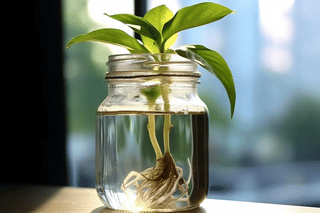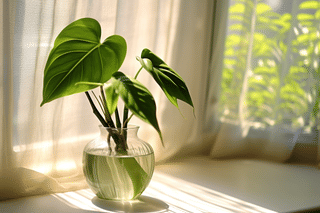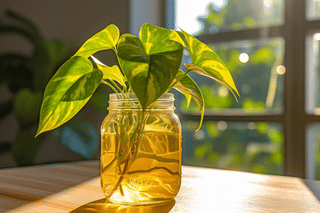How to Boost Your Propagation Success with Leaves on Stem Cuttings
Unlock the secret to successful houseplant propagation with this comprehensive guide. Learn why leaves are essential for stem cuttings, how they help with photosynthesis, store nutrients, balance hormones, adapt to environmental changes, and signal plant health. Increase your cuttings' survival rate today!
Propagating houseplants from stem cuttings is one of the easiest ways to get more plants for free. Taking stem cuttings and growing plants is quite an easy process for most plants.
But did you know it's important that your stem cutting should have a few leaves to give your cutting the highest chance of success? Are you curious to find out why you should keep a few leaves on your houseplant stem cuttings?
Let's find out why!
Leaves are vital for photosynthesis
When you've taken a stem cutting from your houseplant, it likely won't have any roots yet. The lack of roots on a stem cutting makes it very difficult for your cutting to absorb water and nutrients.
This is where leaves come in handy. Leaves carry out photosynthesis, a process that converts light energy to chemical energy, producing glucose and oxygen. This glucose helps to feed your plant.
Without leaves, a stem cutting cannot carry out photosynthesis, and as a result, will have limited energy reserves. That's why it's so important to have leaves on a stem cutting, as it helps it continue to produce energy through photosynthesis.
Leaves hold nutrients for the plant
When you cut a stem from a plant, it loses its main source of nutrients: the parent plant. Leaves play an important role in storing nutrients for growth. They store nutrients and carbohydrates that can keep the cutting alive during the early stages of root development.
The leaves will feed and help to keep the cutting alive before the roots can start to absorb nutrients and take over as the main source of nutrients for the plant.
Leaves balance the hormones in the cutting
Hormones play a vital role in plant growth and development. Auxin is a hormone responsible for promoting root formation. When your stem cutting has a few leaves, they can produce and transport auxins to the base of the cutting, encouraging root development. The leaves can also help to prevent the accumulation of ethylene, a plant hormone that accelerates the aging process of the cutting.
Leaves help with dealing with environmental changes
Leaves contain chlorophyll, the pigment that captures light energy during photosynthesis. Having leaves allows the cutting to adjust to changes in light, and keeps producing energy for the plant.
Leaves also regulate humidity by controlling transpiration rates, helping the cutting adapt to different levels of humidity and preventing excessive water loss. Just like us, plants can sweat and lose moisture through their leaves. When the moisture evaporates, the air becomes more humid around the plant and helps to protect the cutting.
Leaves show early signs of stress
The last reason why you should have leaves on your cutting is the fact that leaves are often the very first thing that should you the plant isn't happy. Healthy leaves are usually vibrant and firm, showing that the cutting is doing well.
Check your stem-cutting leaves often. If the leaves turn yellow or drop off, it could be a sign that something is wrong. It could mean the cutting is in bad condition or not being taken care of properly. Checking the leaves helps make sure the cutting grows healthy and strong.
Conclusion
In conclusion, leaves play a crucial role in the success of propagating your houseplants from stem cuttings. Remember, they are your plant's lifeline, enabling photosynthesis, storing nutrients, balancing hormones, adapting to environmental changes, and signaling plant health. So, next time you're propagating, ensure your cuttings have a few leaves to increase their chance of survival and growth.
Thank you for reading this post! I hope it helps you to keep your plants healthy and beautiful! If you're looking for more guides on specific plants, you can always request a plant guide to get a guide for the plant you have trouble with.
Test your plant care knowledge
Quiz completed!
Want to learn more? Sign up for my newsletter to receive free tips in your inbox!
Sign up now!






